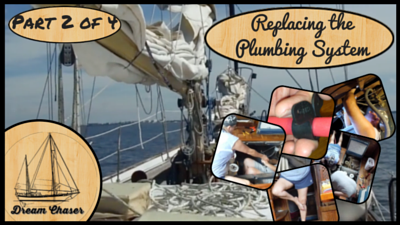This blog post is a continuation of our 4 part series on completely replacing the fresh water plumbing system in your boat. Welcome to installment #2. When we left off on the last blog post, we had just planned out the new system on paper calculating the # of hot and cold runs and fitting required.
(Click below for the link)
Part 1 of Replacing the Plumbing System in the boat
The first step for us was to start in the bilge and remove the panels to the engine room so we can climb down below the sole and gain access to old plumbing lines to be removed. In DreamChaser is it like a balancing beam act every time we remove these panels where we cross the galley on a 2X4 that helps support the floor panels.
As we went into this project and got started, we found a lot of things that needed to be moved to get access to the fitting to be removed. We ended up getting a bit distracted by removing one of the old 8D batteries and finding that the drop in the floor under the galley seats was pretty nasty. Past leaks had it a bit weakened, and we ended up removing the old battery, then removing the floor panel. Once it was removed, we were able to climb into the floor from within there, and while I was not able to reach the compressor for the Freezer cold plates from this position, Deb was. She cleaned the fins and vacuumed all of the dust out of the unit.
Back to the plumbing. With the battery out of the way, we were able to disconnect the T fittings on the copper lines and then go to the rear head and remove the single faucets from the counter. We also cut and removed the copper lines back there as well and kept all of the copper in bins (what the heck, we can recycle it and get enough money to buy a beer, maybe).
After removing the lines from the galley to the rear head, it was time to remove the lines under the sole. Climbing into the engine compartment on my back and sliding backward with my head somewhere between the transmission and the prop shaft, I was able to remove the strapping that held the copper lines to the bottom of the sole and cut the lines and remove them.
We then cut the cold water line going to the aft portion of the boat, however, when we did, hot water continued to run out of it. This is not what should happen and after further review we found that it appears when the system was installed in the past, it was missing a critical piece. There should always be a check valve (or one way valve) that allows cold water to go into the hot water heater, but not flow back down the line into the cold system. That was not the case here. For a few minutes, I had through I cut the wrong line and after quite a bit of double checking we found that check valve issue. See the diagram on the left from a Jabsco web page that demonstrated the proper installation. This is something that is repeated in all reference material for implementing pressure water on a vessel.
Luckily for us, the hot water tank had been turned off for the better part of the day, and the water was not all that hot. Had we been running the engine and that water were heating up via the engines Heat Exchanger instead it could have easily resulted in some severe burns, so always be careful when cutting plumbing lines (especially the hot side, but as this illustrates, the cold can be dangerous too if not properly installed previously.
We repeated this removal process through the whole boat including the forward head sink, plumbing to the forward fresh water flushing head and the forward shower/tub.
The next blog post we will go into details on how to install the new lines, make the connections and tips and tricks in this area.
Below is a list of the materials and connections we used for this project. I think it is important to understand that there are a couple of different ways to connect PEX connections together. For the sake of this discussion, I will keep it to two. But will point out that there are 3 different variety of crimping methods The one I like best is the one that has a small crimping device (About twice the size of large vice grips) as opposed to the very long handled crimp style. With this one you have to use a gauge to determine if the crimp is tight enough or the kind that you have to stretch the PEX and allow it to shrink back into shape over the fitting.
When we did our last boat, we used the nontool variety. They were easy. However, they were much larger and more expensive. For small jobs, I would use them every day of the week. At about $10 per T fitting for the Sharkbite (or non tool) variety, versus $1.50 for the crimp on style, it quickly becomes a better decision to use the crimp on if you are going to use enough to warrant the purchase of the crimp tool for $60 or so.
Below are the items and links of the items we used if it helps.
In the next part of the series, we will make connections and show how easy it is.
Please don’t forget to comment, like or share what you see here on social media or your favorite forums if the topic is relevant.
Below is a link to Part 2 of the 4 part series on Youtube. I hope you enjoy some of the bloopers and fast motion video at the end of this.
[embedyt] https://www.youtube.com/watch?v=wI2htn0g0Zk[/embedyt]


















